Conceptualisation of space and time
Before we sketch some of the models and concepts of spatial and temporal orientation in Awyu-Ndumut communities, it is important to re-emphasize multilingualism and different histories of the various Awyu-Ndumut communities. Most Awyu-Ndumut speakers, especially those in downstream areas where contact with varieties of Indonesian has been going on since the early twenties and thirties of the last century, speak one or two Papuan languages, sometimes of different language families, and in addition to that a local variety of Indonesian. Since Indonesian reflects other models of spatial and temporal orientation than the local Papuan languages, speakers have access to different modes of temporal and spatial orientation and combine them smoothly, just as they combine for example Indonesian numeral systems and entirely different Papuan numeral systems.
It is not just that speakers may combine and switch between such modes, the modes themselves are subject to change in different ways in different parts of Awyu-Ndumut area. Where people (most of the time) live in tree houses on their clan territories, the tree house plays a central role in the conceptualization of time, as is the case for Korowai clans in the north and upstream along the Ndeiram and Becking. But in other parts of the Awyu-Ndumut area people live mostly in kampung houses and the importance of tree houses is greatly diminished and borrowed time concepts from Indonesian have become crucial.
I. Spatial orientation
Spatial orientation as reflected in Awyu-Ndumut languages and texts reflects the following three relatively independent but systematically combined ways of spatial orientation among Awyu-Ndumut speakers:
- orientation in terms of the speech act location,
- stream-based spatial orientation and
- clan territory/tree house-based spatial orientation.
(1) Deictic orientation: static three-way system and dynamic two-way system
Deictic orientation in terms of the location of the speech act and speech act participants is in all Awyu-Ndumut languages a three-way distinction (here, close to speaker; close to addressee/there at short distance; away from speaker or addressee/there at greater distance) expressed in three deictic roots. By adding postpositional clitics to these roots demonstratives and adverbs are formed. The adverbs tend to have both spatial and temporal readings (here/now, there/then). In verbs of motion, the distinction is binary, movement towards speech act location or movement away from speech act location. The roots of the verbs of going (away from speech act location) tend to be the same or similar to the place deictic root that expresses ‘away from speaker/hearer’ and the root of the verbs of coming tend to be the same or similar to the deictic root that expresses proximity to the speaker. For example, in Yonggom Wambon (Drabbe 1959: 121) the three deictic roots are me ‘here’, ep ‘there/short distance’ and kop ‘there, away from both speaker/addressee’. The verb of coming is me- and of going is ko-. By adding postpositional clitics, the demonstratives mene ‘this’, ewe ‘that’ and kore ‘that over there’ are formed.
The basic static three-way system and dynamic two-way system described above (movement away from/toward speech act location) is optionally but frequently modified and specified by directional elements based on the fundamentals of Awyu-Ndumut cultural and natural geography: stream-based directionals or tree house-based directionals. Morphosyntactically, this modification may take the form of compounds, serial verb constructions or chained clauses.
(2) Stream-based spatial orientation
The most important source for directional modifiers are stream-based categories. All rivers and streams have proper names, unlike most other features of the landscape. The rivers and streams form the core of the cultural geography of Awyu-Ndumut speakers, who live in dense rainforests where streams and rivers are practically the only way to orient oneself spatially. Stream based orientation is both absolute, in terms of names of rivers and streams, and relative to the speech situation (upstream relative to speaker’s position, downstream from speaker’s position, on the other side of the stream from speaker’s position/on this side of the stream). Figure 1 outlines Korowai stream-based spatial deictics (from Stasch 2001: 37, fig. 2.1):
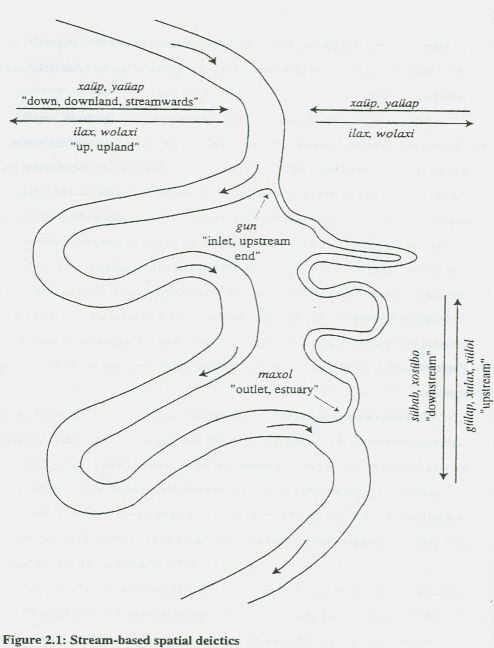
Stasch (2001: 36) writes: “All Korowai speech is saturated with the words for these stream-based directional categories, whether people are describing travel across the landscape, the motion of the sun or any other atmospheric entity, the position of an object in a house or in someone’s bodily vicinity, or an endless variety of further kinds of spatial relationships of diverse scales. Ego-centric body-based spatial terms, such as “right” and “left”, are seldom heard….Nor does the language have any strict cardinal spatial categories akin to English “north”, “south”, “east” and “west”. Rather, stream-based categories are all-important.”
Especially the directional stream-based deictics for upstream and downstream relative to the speaker’s position occurs very frequently in Korowai speech, not just in combination with verbs coming and going as directional modifiers of the motion (moving upstream/moving downstream) but also in a more absolute sense meaning something like east (upstream) and west (downstream), because the landscape at large is construed as a stream (Stasch 2001: 38). The point where the sun sets on the horizon is the sun’s maxol ‘downstream end’ (see figure 2.1) and where it rises is its gun ‘upstream end’ (Stasch 2001: 59). Not only the sun and the landscape at large but also other domains are spatially understood in stream-based categories. Perhaps the most significant example of this is the division of the tree house where a center wall separates the men’s territory from the women’s territory; the side of the tree house on which the rising sun shines is the ‘upstream’ side, the westerly side, and the other side the ‘downstream’ side, the easterly side. Men say that the reason why women occupy the ‘downstream’ side of the house is that if it was reversed the sun would push menstrual odors and substances downstream toward the men, causing health problems (Stasch 2001: 152). This motivation of Stasch’s Korowai speakers will be understood immediately by all Awyu-Ndumut speakers because such gendered pollution taboos are very common and also active in contexts such as church services where women and children sit separate from the men. In conclusion, Korowai stream-based conceptualization of space has taken symbolic meanings far beyond spatial orientation. In the words of Palmer (2007: 1062): “When several salient cultural linguistic domains are linked with space in pervasive symbolic complexes, almost any orientational expression takes on metaphorical and metonymic values”.
(3) Clan territory/tree house and hill-based spatial orientation
The named patriclan lands are also a major source for spatial orientation, and one that is, perhaps surprisingly so, relatively independent from stream based orientation or in the words of Stasch (2001:53) about Korowai: “Homeland ownership and patriclan identity are not centrally defined around waterways.” On the clan lands there are clearings in the jungle, light open spaces that form a strong contrast with the semi-darkness under the canopy of the rainforest.
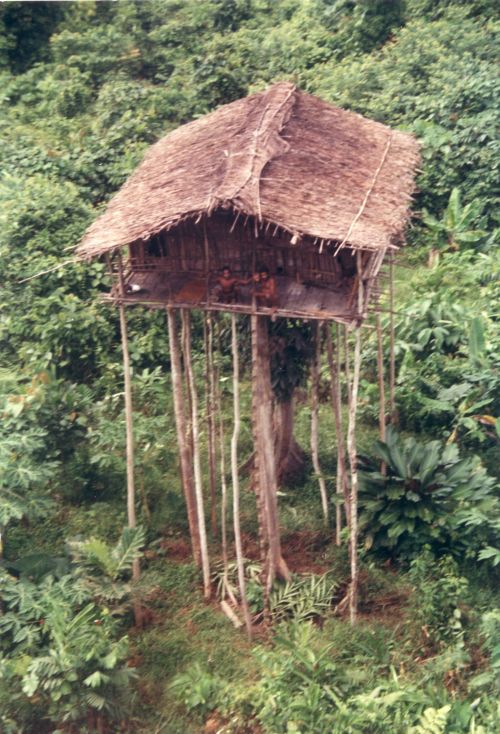
Veldhuizen, 1986, Bilambanen treehouse
The tree house that stands in the middle of the clearing has a long vertical pole with carved out places for the feet. Entering a tree house is described as movement up this pole, leaving the house as movement vertically down. Often in texts of Awyu-Ndumut languages when the verb of climbing up or climbing down is mentioned, the tree house is left unmentioned and the verbs of ascending/descending have become idiomatic expressions for entering and leaving the house.
Some parts of the Awyu-Ndumut lands are hilly as these languages are spoken also in the southern most part of the foothills of the central mountain range. Accordingly, with verbs of coming and going directional modifiers specify whether movement is uphill or downhill or whether an entity is located uphill or downhill.
The three modes of spatial orientation combined
The demonstratives of Aghu (Drabbe 1957: 24) and motion verbs are an example of the combination of basic deictic verbs of coming and going modified by directionals from the domains of streams, tree houses and hills. In (2) we see how the verbs of coming and going are used for the movements of the participants in the story away from the tree house and towards the tree house. The tree house is not mentioned because the verb mi- ‘to come/climb down from a tree, tree house or other high object’ is used and the only thing one can climb down along when one leaves the tree house in the morning is the vertical pole with notches for the feet that serves as the stairs for a high house:

The Aghu demonstrative gho ‘that’ (away from speaker and addressee, with the same root as the verb gho- ‘to go’) can be used without directional modifying roots or in compounds with other roots that are stream-, hill- or tree house-based and that are also used as roots of directional verbs:
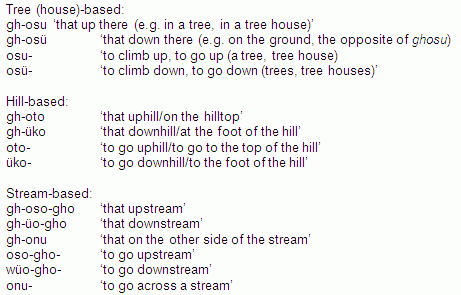
All these demonstratives and verbs also can be modified by a root go- that means ‘a short distance’ : ghosu ‘that up there’ and ghogosu ‘that a little up there’. In addition, the directional verbs given above that are all glossed with ‘to go’ (to go downstream, to go across a stream, etcetera) all have counterparts with a an added root m(a)- and then have the meaning ‘to come’ (to come downstream, to come across a river, etc.). The directional verbs with m(a)- have mostly very similar but not quite identical roots as their counterparts, with the exception of mi- ‘to come down (a tree, tree house, from the air)’, with osü- ‘to descend, to go down (a tree, tree house)’ as counterpart:

The verb osü- ‘to go down a tree/tree house’ is also used with the meaning ‘to go downstream’ according to Drabbe (1957: 25) who adds that the specific term for going downstream is wüo-gho-. Similarly, the verb mi-da- ‘to come downhill’ is also used for coming downstream. In other words, motion verbs from one domain may do double duty in another domain. In Korowai, the terms for upland/away from stream and downland/toward stream also “do double duty to speak of strictly vertical spatial relations of up and down. (Stasch 2001: 35).
II. Temporal orientation
Contact with the outside world has led Awyu-Ndumut speakers to develop new words for the concepts of weekdays, months and years in their languages.
Until Indonesian loanwords for year (tahun) entered Awyu-Ndumut languages the concept of ‘year’ was absent as far as we know. However, the tree house provided temporal orientation because they last for about one to two years. The Korowai term xaim dem-un (tree house decompose-nom) refers to the period of time in which a tree house falls apart (Stasch 2001: 68) and Stasch (2009: 62) describes how speakers routinely quantify duration in terms of number of this unit of ‘house falling apart’:
“Similarly, people often say “the time of this house” (i-xaim-alüp) to situate an event as contemporary rather than long ago, and they speak of the “era” (-alüp) of specific previous houses to locate events historically. Residents remember each house they have lived in by the species name of its main supporting tree…Many adults can list fifty or more houses they have lived in. As they list each house, speakers readily mention the people with whom they shared domestic space and the life-changing transitions that occurred during their time there.”
In the course of the 1970s the concepts of 'Monday', 'Tuesday' and so forth and of 'January, February' and so forth were introduced by missionaries, traders and government personnel into the Wambon area. The same happened during the 1980s in the Kombai and in the 1990s in the Korowai area. In pre-colonial times the central time concepts were days and months, with the word for 'sun' also denoting the time concept of day, and the word for 'moon' the concept of month. Journeys through the jungle were measured in terms of the numbers of days the journey took. Sago grub feasts were planned in terms of months ('in 3 months we shall have our sago grub feast'). For example Kombai rei 'sun; day', amaga 'moon; month'. Since there are no clear dry and wet seasons in the foothills area of Kombai, Korowai and Wambon where it rains throughout the year, there is no clear pre-contact concept of 'year'. There is a Kombai compound khefe-refe 'wind-drizzle' which is sometimes used for 'year' but given the irregularity of the annual drizzle rains (somewhere between May and July) it is at best a marginal time concept in Kombai culture (for example years of age of people are not counted).
When airstrips were built in the area by the missionaries, Kombai, Korowai and Wambon workers were hired and these worked from Monday to Saturday. On Sundays the missionaries held church services. The missionaries used Indonesian terms for 'week' (Ind. minggu) and for the 7 days of the week (Senin 'Monday', etcetera). The opposition between work days and worship days was crucial in the teaching of the mission. Furthermore the use of 'Monday', 'Tuesday' and so forth implied an order of days: Monday comes first, Tuesday second, and so on. Both elements (the order of days, Monday=day number 1 etc. and the opposition between work days and worship days) are reflected in the names for the days of the week that the Awyu-Ndumut languages developed.
Days of the week and months of the year
Kombai and Wambon used the same strategy to adapt the counting system to the new needs of time measurement when government agencies and missionaries entered the area. They formed compound nouns with the noun for 'sun;day' as modified noun and the body part/number nouns from 1 to 7 as modifying nouns. Thus Monday= little finger-day, Tuesday=ring finger-day, etcetera.
To express the opposition between work days and worship days, all three languages may take the Indonesian word for worship sembahyang, adapt it phonologically and use it in a compound noun with the word for 'day' (e.g. Kombai sembayana-rei 'worship-day'). Here is the Kombai system for the days of the week:
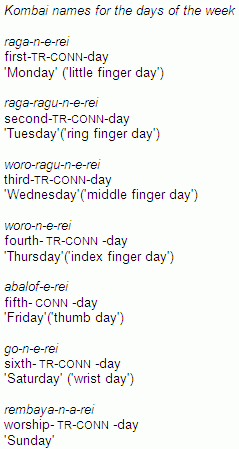
The Wambon use the connective -o to link the body-part modifier to the head within the compound noun:
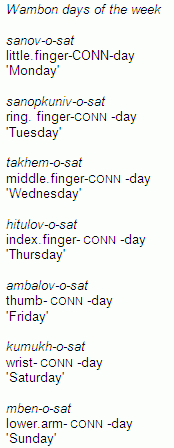
Notice that the innovation to use the number words in compounds denoting the days of the week creates an opposition between the expressions for 'one day', 'two days' and so on, and expressions meaning 'day nr. one, day nr. two' and so on:
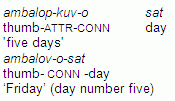
To know the days of the week is of immediate practical importance to the Kombai, Wambon and Korowai people since their work on roads, airstrips and the like is organized in terms of these concepts.
The twelve months of the year initially did not have the same immediate daily impact on their lives, although with the introduction of schools (with holiday months), national elections, the celebration of the Independence Day of Indonesia in August, and so on it is increasingly relevant for them to know the twelve months of the calendar year. In the Wambon area these concepts were first introduced and there the following compound nouns for January (little finger moon), February (ring finger moon), and so on, are used alongside Indonesian loan words:
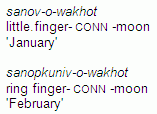
When a day of the week is mentioned, Kombai, Korowai and Wambon speakers, in a kind of automated gestural reflex, touch the relevant body-part, e.g. when gone rei 'Saturday' is mentioned by Kombai speakers, the wrist is touched. This reflex originates in their bodypart tally system of counting.
